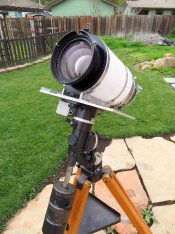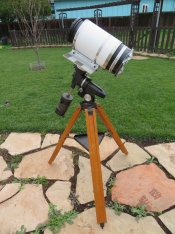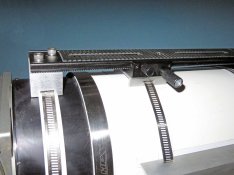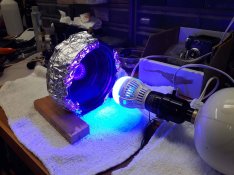Matt Hall
Member
Hi everyone! I am fairly new to Phototrio and wanted to share a project I have been working on for some years now. In 1985 I purchased this Aero Ektar 12-inch f/2.5 lens (dated to 1953 using the serial number) from a military surplus outfit in Pasadena, CA that I'm fairly sure doesn't exist anymore. I was heading down to New Zealand with a group from Brooks Institute to shoot Comet Halley and thought a large format astro camera would be really cool. The head of the Industrial Dept. at Brooks, Vern Miller, turned me onto this lens. Unfortunately, I never got it finished and it got put into storage until about a year ago. When I rediscovered it I decided it was time to finish the project. Although Vern has passed several years ago I know he would have been proud to be apart of this effort.
I had to clear the rear lens group as it was quite brown from age due to the Thorium/Lanthanum fused into the glass to get the required dispersion characteristics the government needed for an aerial lens. I used a 5W UV LED bulb purchased on Amazon and left it on about 2 inches from the rear glass grouping for 7 weeks, 24/7. As it was just 5W there was no appreciable heat to damage the lens. It finally completely cleared up. Turns out I was losing 2-3 stops of light due to the discoloration which completely defeated the f/2.5 speed of the lens. With the help of a machinist to cut the threads on the lens mount I slowly built this camera. It has a rack and pinion focus mechanism with a locking screw (needed if you are pointing vertically) and I am working with Rick Oleson to create a 4x5 Bright Screen ground glass for me to aid in framing the image. I found a NOS 6"x 6" Aero 2 yellow filter (minus violet as this is an achromat) which I will use just as the military did when shooting this with IR B&W film. I am using the 4x5 rotating back from my old view camera while at Brooks (it worked great then so why not?). The entire thing was placed onto my GEM this last Saturday to make sure the weight was good and I had enough counterweight. etc. The entire camera weighs 28 pounds (most of that is the glass). I turned it to the Moon and could clearly see the surface craters on the ground glass. I was a bit surprised just how sharp it is (I did use a magnifying loop to aid in focusing). Anyway, I have some Porta 400 sheet film coming from B&H which I will have pushed 2 stops during processing to get a 1600 equivalent ASA rating. Think my first shots will be of Orion as it is in the right place and contains several bright stars to aid in focusing this beast. Just waiting for the Moon to get out of the way now so I can make my test exposures. Any comments or ideas would be welcomed!
I had to clear the rear lens group as it was quite brown from age due to the Thorium/Lanthanum fused into the glass to get the required dispersion characteristics the government needed for an aerial lens. I used a 5W UV LED bulb purchased on Amazon and left it on about 2 inches from the rear glass grouping for 7 weeks, 24/7. As it was just 5W there was no appreciable heat to damage the lens. It finally completely cleared up. Turns out I was losing 2-3 stops of light due to the discoloration which completely defeated the f/2.5 speed of the lens. With the help of a machinist to cut the threads on the lens mount I slowly built this camera. It has a rack and pinion focus mechanism with a locking screw (needed if you are pointing vertically) and I am working with Rick Oleson to create a 4x5 Bright Screen ground glass for me to aid in framing the image. I found a NOS 6"x 6" Aero 2 yellow filter (minus violet as this is an achromat) which I will use just as the military did when shooting this with IR B&W film. I am using the 4x5 rotating back from my old view camera while at Brooks (it worked great then so why not?). The entire thing was placed onto my GEM this last Saturday to make sure the weight was good and I had enough counterweight. etc. The entire camera weighs 28 pounds (most of that is the glass). I turned it to the Moon and could clearly see the surface craters on the ground glass. I was a bit surprised just how sharp it is (I did use a magnifying loop to aid in focusing). Anyway, I have some Porta 400 sheet film coming from B&H which I will have pushed 2 stops during processing to get a 1600 equivalent ASA rating. Think my first shots will be of Orion as it is in the right place and contains several bright stars to aid in focusing this beast. Just waiting for the Moon to get out of the way now so I can make my test exposures. Any comments or ideas would be welcomed!











